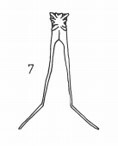Symmetrikiexafanisi furcatolithoides
Set number: 950
-
1
-
2
-
3
-
4
-
5
-
6
-
7
-
8
-
9
-
10
-
11
-
12
10µm
Sphenolithus furcatolithoides Locker, 1967
1967 Sphenolithus furcatolithoides Locker, p. 363, Pl. 1, Figs. 14-16; Text-figs. 7-8
Sphenolithus furcatolithoides labradorensis Firth,1989
Sphenolithus cuniculus Bown, 2005d
2014 Sphenolithus furcatolithoides Locker, 1967 morphotype A - Agnini et al. in Cappelli et al., pl. 3, figs 2, 3.
2014 Sphenolithus furcatolithoides Locker, 1967 morphotype B - Agnini et al. in Cappelli et al., pl. 3, figs 11, 12.
2021 Sphenolithus shamrockiae Howe, p. 53, Pl.2, Figs. 1-4
Optical Properties: The diverging apical spines and the segments of the proximal cycle exhibit symmetrical extinctions. The lateral cycle displays parallel extinction and length-fast (-) elongation. Under XPL, when the specimen is oriented at 45°, the lateral cycle, supplementary segment, and a segment of the proximal cycle (observed from its length) create a cross in well-preserved specimens.
Large species of Symmetrikiexafanisi (often greater than 7.0 μm) exhibit a moderately high proximal cycle, a fragile lateral cycle, and diverging twin apical spines after varying heights of an initially joined section. A short supplementary segment between the apical spines is visible only when the specimen length is 45° under XPL in well-preserved specimens.
Symmetrikiexafanisi furcatolithoides is distinguished from Symmetrikiexafanisi magnifica and Symmetrikiexafanisi cubaensis by diverging apical spines after varying heights of an initially joined section.
Bown, P. R. 2005d. Palaeogene calcareous nannofossils from the Kilwa and Lindi areas of coastal Tanzania (Tanzania Drilling Project 2003-4). Journal of Nannoplankton Research 27(1): 21-95.
Bukry, D., 1971b. Cenozoic calcareous nannofossils from the Pacific Ocean. - San Diego Society of Natural History Transactions 16, 303-327.
Firth, J. V., 1989. Eocene and Oligocene calcareous nannofossils from the Labrador Sea, ODP Leg 105. Proceedings of the Ocean Drilling Program, Scientific Results 105, 263-286.
Locker, S., 1967. Neue Coccolithophoriden (Flagellata) aus dem Alttertiär Norddeutschlands. Geologie, Berlin 16, 361-364.
Varol, O. 2025. A practical guide to optical studies of calcareous nannofossils. Grzybowski Foundation Special Publication, 29, 230 pp.

